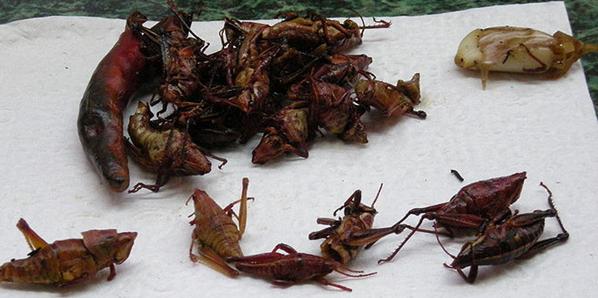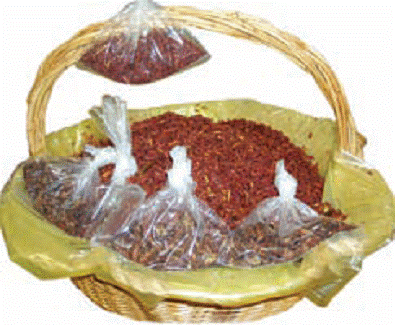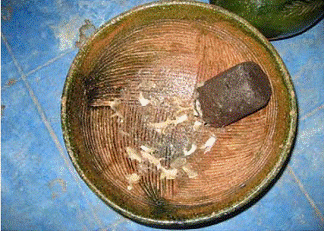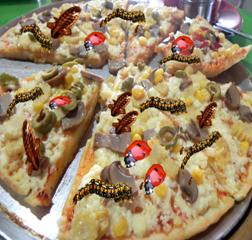 |
|||||||||||||
| LEAD Action News Volume
13 Number 4, June 2013, ISSN 1324-6011 Incorporating Lead Aware Times ( ISSN 1440-4966) and Lead Advisory Service News (ISSN 1440-0561) The Journal of The LEAD (Lead Education and Abatement Design) Group Inc. Editorial Team: Elizabeth O’Brien, Zac Gethin-Damon, Hitesh Lohani, Shristi Lohani and David Ratcliffe |
|||||||||||||
|
About Us
|
Keep leaded six leggeds out of FAO edible insect strategy By Shristi Lohani, Volunteer, The LEAD Group Inc. and Editor, Pristabhumi e-newsletter for ex-patriot Nepalese worldwide. The following article was originally published in Pristabhumi online magazine under the Hungry title shown below. Introduction with a lead warning, for LEAD Action News, by Elizabeth O’Brien, BSc, Dip. Health Ed. Introduction Although the burden of lead poisoning has decreased across developed countries, it remains the most prevalent environmental poison worldwide.
So begins a 2003 research article investigating the sources of an outbreak of lead poisoning in Monterey County, California – the source turned out to be a snack food: chapulines (grasshoppers) from Mexico. Photo: fried chapulines (grasshoppers) in Oaxaca with a chili and a clove of garlic. AlejandroLinaresGarcia, Wikipedia 2013. The Wikipedia page on chapulines (plural for chapulin), lists two Health risks for people eating the grasshoppers:
A California
health department warning in November 2003 stated: “Recent
analysis of chapulines from Oaxaca, Mexico, showed that they may contain as
much as 2,300 micrograms of lead per gram of product. The U.S. Food and Drug
Administration (FDA) has recommended that children under age 6 should consume
on average no more than 6.0 micrograms of lead each day from all food sources.
A young child eating one of these highly contaminated chapulines could ingest
nearly 60 times his or her tolerable daily intake for lead. While some of the
chapulines analyzed contained no detectable lead, consumers have no practical
way of determining if the product is
Photo at left: The New York City Health Department published a fact sheet in English, Spanish, Chinese, French, Arabic, Hindi, Urdu and Bengali, with this photo of chili chapulines, advising that people avoid some Mexican snacks, “especially those flavored with chili powder”. Photo at right (below): Lead-glazed “chirmolera” (clay pot) used for grinding spices in the Zimatlán District, in Oaxaca, Mexico. (Villalobos et al, 2009)
(1) encourage a decrease in use of cookware that is most able to transfer lead into foods, even without heating. …Recent collaborations between a pottery-producing community organization that does not use lead in the glazing may result in replacement of lead-containing products with those that are lead-free …and as well, other cookware such as traditional stone-made “molcajetes”, or non-glazed clay utensil cookware can become suitable substitutes; (2) increase awareness of the lead risk from soil [contaminated with mine tailings]. The Wikipedia page on insects and other creepy crawlies being eaten by people, gives the following definition: Entomophagy (from Greek ἔντομον éntomon, "insect", and φᾰγεῖν phagein, "to eat") is the consumption of insects as food. Insects are eaten by many animals, but the term is generally used to refer to human consumption of insects; animals that eat insects are known as insectivores… Entomophagy is sometimes defined broadly to include the practice of eating arthropods that are not insects, such as arachnids (tarantulas mainly) and myriapods (centipedes mainly). And adds two more health warnings: 3. pesticide use can make insects unsuitable for human consumption. [NB lead arsenate is still used as a pesticide in countries where it has not been banned]; 4. Adverse allergic reactions are also a possible hazard. MAIN ARTICLE Hungry...how about a
caterpillar pizza?? Food is the basic necessity of human life. With the rapidly increasing population, human being has been demolishing numerous natural resources to fulfill his hunger. To discover alternatives for feeding the human beings, various scientific researches have pointed to a whole new spectrum of food prospects, one being the insects. Yes, you have heard it right, those slimy, scary, yucky looking species which are one of the easily available and protein rich resource of food. According to FAO (Food and Agriculture Organization of the United Nations) in the news article “Forest products critical to fight hunger - including insects”, insects can also be considered as a major option for food and feed. Insects are already being plated up in the conventional diet of at least two billion people worldwide. In accordance to FAO’s research conducted in partnership with Wageningen University in the Netherlands, more than 1900 insect species are consumed by humans (Food and Agriculture Organization of the United Nations, 2013). FAO also stated that “with about 1 million known species, insects account for more than half of all living organisms classified so far on the planet.” Hence, Food and Agriculture Organization of United Nation(2013) describes that universally, the most consumed insects are:
In terms of dietary requirements most of the insects are rich in protein and good fats and high in calcium, iron and zinc. Economically as well, insect gathering and farming can provide employment and cash flow strengthening the country’s economy. Not only for livestock feeding, insect use for meat can also be highly regarded cost efficient. As insects are cold-blooded, they don’t utilize energy from feed for maintaining body temperature. FAO describes that, on average, insects utilizes just 2 kg of feed to produce 1 kilo of insect meat, whereas, cattle require 8 kg of feed to produce 1 kg of beef. Moreover, insects produce a fraction of emissions for example: methane, ammonia, climate-warming greenhouse gases and manure, all of which contaminate the environment. Insects can also be utilized to break down waste, helping in the composting processes delivering nutrients back to the soil while also diminishing foul odors. Health wise as well scientists have discovered that insects are so biologically different from mammals that it is highly unlikely that insect diseases could be transmitted to humans.Therefore, don’t be surprised to have insects on the menu in future and who knows they might be one of the yummiest delicacies you ever tasted. Photoshopped Insects on pizza: Shristi Lohani References: Food and Agriculture Organization of United Nation. (2013). Forest products critical to fight hunger-including insects. Retrieved from http://www.fao.org/news/story/en/item/175922/. |
||||||||||||
|
About
Us |
bell
system lead poisoning |
Contact Us
| Council
LEAD Project | egroups | Library
- Fact Sheets | Home
Page | Media Releases |
|||||||||||||
|
Last
Updated 19 July 2013
Copyright © The LEAD Group Inc. 1991- 2013 PO Box 161 Summer Hill NSW 2130 Australia Phone: +61 2 9716 0014 |
|||||||||||||

 contaminated
with lead.”
contaminated
with lead.” According to Villalobos M,
et al,
According to Villalobos M,
et al, 